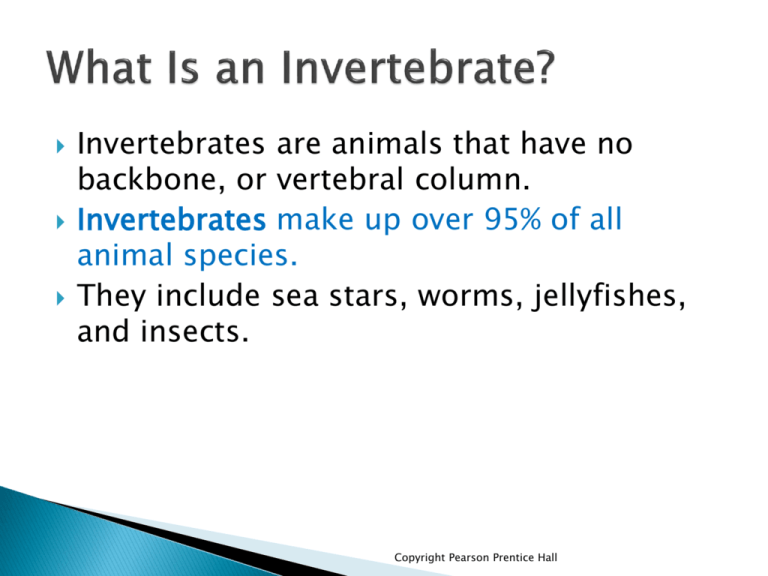
Invertebrates are animals that have no
backbone, or vertebral column.
Invertebrates make up over 95% of all
animal species.
They include sea stars, worms, jellyfishes,
and insects.
Copyright Pearson Prentice Hall
Copyright Pearson Prentice Hall
What is a Sponge?
Sponges are the simplest and most
ancient animals
in the phylum Porifera which means
“pore-bearers.”
live their entire adult life as sessile
organisms; attached to a single spot.
Copyright Pearson Prentice Hall
◦ Body Plan
Sponges are asymmetrical; they
have no front or back ends, no
left or right sides.
Copyright Pearson Prentice Hall
◦ Feeding
Sponges are filter feeders.
As water moves through the sponge,
food particles are trapped and engulfed
by choanocytes that line the body cavity.
Copyright Pearson Prentice Hall
◦ Circulation
Sponges rely on movement of water
through their bodies to carry out body
functions.
Copyright Pearson Prentice Hall
Branching Tube Sponge
Stove Pipe Sponge
Vase Sponges
Barrel Sponges
Ball Sponges
Rope
Sponges
Copyright Pearson Prentice Hall
What is a Cnidarian?
Cnidarians are soft-bodied,
carnivorous animals that have
stinging tentacles arranged in circles
around their mouths.
Copyright Pearson Prentice Hall
Body symmetry
◦ Cnidarians are radially symmetrical. They
have a central mouth surrounded by
numerous tentacles that extend outward
from the body.
Copyright Pearson Prentice Hall
◦ Feeding
A cnidarian pulls its food through its
mouth and into its gastrovascular cavity,
a digestive chamber with one opening.
Food enters and wastes leave the body
through that same opening.
Copyright Pearson Prentice Hall
◦ Circulation
Following digestion, nutrients are usually
transported throughout the body by
diffusion.
Copyright Pearson Prentice Hall
Portuguese
man-of-war
•Colonial Hydrozoan
(not a single
organism
•Tentacles sting prey
such as fish &
humans
•Polyps in colony feed
•Has gas-filled air float
copyright cmassengale
23
Anthozoans
copyright cmassengale
24
Hydra Feeding
copyright cmassengale
25
Food in
Gastrovascular
Cavity
copyright cmassengale
26
Scyphozoans
copyright cmassengale
27
Some Jellyfish Show
Luminescence
Copyright Pearson Prentice Hall
Flatworms are acoelomates, which means
they have no coelom.
A coelom is a fluid-filled body cavity that is
lined with tissue derived from mesoderm.
The digestive cavity is the only body cavity
in a flatworm.
Flatworms have bilateral symmetry.
Copyright Pearson Prentice Hall
◦ Feeding
Flatworms have a digestive cavity with a
single opening through which both food
and wastes pass.
Near the mouth is a muscular tube called
a pharynx.
Flatworms extend the pharynx out of the
mouth. The pharynx then pumps food
into the digestive cavity.
Copyright Pearson Prentice Hall
◦ Circulation
Flatworms do not need a circulatory
system to transport materials they rely
on diffusion
Copyright Pearson Prentice Hall
Copyright Pearson Prentice Hall
Copyright Pearson Prentice Hall
Roundworms
◦ Roundworms are unsegmented worms that
have pseudocoeloms and digestive
systems with two openings—a mouth and
an anus.
◦ Roundworms have bilateral symmetry.
Copyright Pearson Prentice Hall
◦ Feeding
Many free-living roundworms use
grasping mouthparts and spines to catch
and eat other small animals.
There are a variety of parasitic
roundworms as well
Copyright Pearson Prentice Hall
◦ Circulation
They depend on diffusion to carry nutrients
and waste through their bodies.
Copyright Pearson Prentice Hall
Copyright Pearson Prentice Hall
What Is an Annelid?
◦ Annelids are worms with segmented
bodies. They have a true coelom that is
lined with tissue derived from mesoderm.
◦ Annelids have bilateral symmetry.
Copyright Pearson Prentice Hall
◦ Feeding and Digestion
In carnivorous species, the pharynx
usually holds two or more sharp jaws
that are used to attack prey.
Annelids that feed on decaying
vegetation have a pharynx covered with
sticky mucus.
Other annelids obtain nutrients by filter
feeding.
Copyright Pearson Prentice Hall
◦ Circulation
Annelids typically have a closed
circulatory system, in which blood is
contained within a network of blood
vessels.
Copyright Pearson Prentice Hall
Copyright Pearson Prentice Hall
Copyright Pearson Prentice Hall
Copyright Pearson Prentice Hall
Copyright Pearson Prentice Hall








